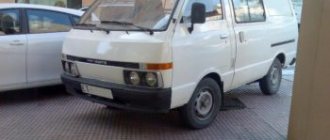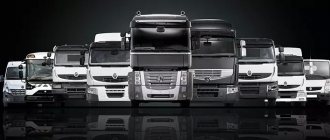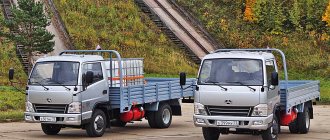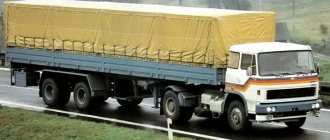Posted by Poker Face
15 October 2022 09:14
Community: Autoworld
Tags: Berliet Berliet T100 auto autoworld cars truck dump truck
1867
11
The now defunct Berliet company was once famous for its trucks. At one time it was the largest manufacturer of heavy-duty trucks in France. By the mid-1950s, the company was producing 10 thousand cars. In addition, Berliet had extensive experience in the design of mining dump trucks, heavy-duty tractors and other specialized equipment with particularly large payloads.
0
Source:
See all photos in the gallery
The company's highest achievement in this field was the giant Berliet T100 trucks with a gross weight of 100 tons.
First series car
0
Source:
In the early 1950s, active preparations for industrial oil production were underway in French Algeria. The matter was complicated by the fact that the work took place in hot and desert conditions. In other words, oil companies needed a specialized truck with good cross-country ability and high carrying capacity. In 1956, to assess the transport needs of oil workers, a representative of the Berliet company, Paul Berliet, went to Algeria. As a result of this trip, already at the beginning of 1957, the company began to develop a unique truck with a carrying capacity of 50 tons. The car was built in a record 8 months, and in October 1957, the world's largest truck was presented at the Paris Auto Show.
×
0
Source:
The total weight of the car was 100 tons, from which it received the name Berliet T100. It was a huge (15 m long and 5 m wide) three-axle truck with a 6x6 wheel arrangement. It was based on a spar frame with powerful cross members and a lowered front part. The suspension of all wheels is dependent spring, the rear is balanced with stabilizers. There were four hydraulic shock absorbers only on the front axle. They were manufactured by special order at the Messier company, which produced aircraft landing gear and braking systems. In addition to shock absorbers, Messier has prepared disc brakes that are protected from fine sand and dirt.
0
Source:
The engine and gearbox also had to be looked for externally; Berliet did not have its own power unit with the required power. The Cummins VT12 12-cylinder V-shaped diesel engine with a volume of 24 liters and a power of 600 hp fits well under the rounded hood. The engine was paired with an 8-speed manual transmission from a diesel locomotive. In case of engine failure, to maintain the operation of the steering and braking systems, there was an auxiliary gasoline engine with a power of 40 hp.
0
Source:
0
Source:
0
Source:
The Berliet T100 looked quite traditional - like an ordinary truck, albeit a very large one. In the front part there was a three-seat bonneted, all-metal cabin, and immediately behind it was a Garwood mechanical winch with a pulling force of 45 tons and a cable length of 75 meters. A steel cargo platform with a slight slope at the rear was mounted at the rear, with a total area of 27.2 m2. Under the platform in the middle part of the vehicle there were two fuel tanks with a capacity of 950 liters. The plan was to install more massive wheels, but Michelin did not have time to produce tires in time, so smaller wheels with a diameter of 1.8 m were installed on the first Berliet T100.
0
Source:
Berliet: born to surprise
France was another of the greatest colonial powers when the country's leadership decided to integrate the territory of the Algerian Sahara as much as possible under its protectorate. Geologists have identified new deposits of oil far below the hot desert surface, which requires new technologies for its development and, accordingly, new logistics for the delivery of modern equipment and everything necessary.
By the late 1950s, it was a logistical nightmare because there were no mobile vehicles that could carry the heavy load to the well. The French government commissioned specialists at Berliet to design a vehicle that would do the job.
Thus the T100 project was launched and Berliet, as a leading premium truck manufacturer, quickly found a solution. The French car manufacturer sent a team of engineers to Algeria to study the geographical conditions, and the delegation could return home with the final idea for creating the desired car. The researchers completed the task, and after a week of wild desert heat, they discovered that the truck had to be much larger than any model the brand had previously made. That's what it became - the biggest truck!
Development work began in January 1957 and with a rather unusual move - the purchase of the largest Michelin tires. Designers developed the truck design and built the first Berliet T100 in October of that year - after just nine months of development.
Leveraging a number of existing components and technologies from external suppliers helped speed up the process. The French, by the way, installed a ready-made power plant on the truck - they chose a 29.6-liter V12 Cummins with a power of 600 hp. The big engine sent its power to six wheels through a Clark semi-automatic transmission with four forward and four reverse gears. The maximum speed of the desert cruiser was about 34 km/h.
The length of the truck was 13.5 m, height - 5 m, width - 4.4 m, total weight - 111 tons. The 12-cylinder diesel engine received fuel from a pair of 946-liter fuel tanks. The piquant point was that in addition to the Cummins, the car was equipped with a Panhard Dyna engine, which only drove the power steering pump. Thus, it became possible to move a colossal truck on a hitch without starting the main unit. In addition, the machine underwent a series of exhaustive tests to ensure that the parts were resistant to the harsh climate of the Sahara.
During further testing, engineers chose to increase the power of the V12 engine to 700 hp, and the second T100 truck received a more powerful engine on the slipway. The first two T100s were shipped to Africa, while the third was a 10-wheel dump truck ordered by the French government for use in a mine. The fourth sample was sent to the USA as a demonstration prototype.
Collaboration with the Americans could have been promising for Berliet, but production was stuck at just four examples. At the time, no one expected that President Charles de Gaulle would grant Algeria political independence in 1962, which would make French oil production in the area virtually impossible. France logically limited its Sahrawi ambitions and the chances of producing more T100s evaporated.
The first copy made worked for several decades: now it is laid up somewhere in the desert and needs complete reconstruction. The second model returned home in 1981 and was restored to be preserved as a museum piece. The third giant left the field in 1964, helped for some time in the construction of the highway, and then was liquidated. The fourth T100 suffered the same fate and ended up scrapped. Today, the giant truck is simply a memory of better times in the history of the colonial superpower.
Share
Second series car
0
Source:
In 1958, the second Berliet T100 was built. It can be easily distinguished by its enlarged wheels with a diameter of 2.2 m and a small hump on the hood, under which was hidden a forced Cummins VT12, with a displacement increased to 28 liters and a power of 700 hp. In addition, a first-generation Berliet T100 was equipped with new wheels and a motor. In 1961, both cars received a more durable Clark R1400 4-speed semi-automatic gearbox instead of a manual transmission.
Story
The trucks were designed and built in secret and under tight deadlines; the first was completed nine months later at the Courbevoie plant. It was unveiled as a surprise at the 1957 Paris Motor Show.[3] However, it was too large to fit in the main showroom, so Berliet built a special outside pavilion to display the huge new truck. It was then shown at various motor shows - in Lyon, Avignon, Helsinki, Casablanca, Frankfurt and Geneva. He began working in the oil and gas fields of the Sahara; after Algerian independence it became the property of the Algerian government and was retained at Hassi Messaoud.[4]
The second T100 was built in 1958, two more in 1959.
The second T100, which operated in Algeria, was later returned to the Berlier Foundation museum in 1981.[5]
The trucks were stablemates of the Berliet GBO1560 tonne 6x6 truck which was released in 1956. A total of 45 cars were built, most of which were exported to Algeria.[6]
Between two wars
After producing tanks, army trucks, armored cars, artillery tractors and ambulances during the war, Renault accumulated considerable experience in creating reliable, simple and repairable vehicles, highly valued in the 1920s and 1930s. Renault trucks turned out to be the most reliable according to the terms of the competition organized by French motor transport workers in 1921. New engines, brakes and suspensions showed their best side. The radiator was still installed behind the engine, but this did not prevent the cars from successfully performing in numerous runs across Africa and South America. The installation of a cab above the engine was widely used on trucks; in 1935, the widespread introduction of diesel engines began, and in the late 1930s the production of vehicles powered by wood gas was mastered. According to statistics, Renault trucks by the end of 1939 became the most popular in France. Their share in the park reached 40%.
Berliet VPB military vehicle chassis with equidistant axles and all-wheel drive. 1930
Meanwhile, in 1930, Marius Berlier began active work to introduce diesel engines into his cars. As a result, two years later, efficient engines were created, and they began to be installed on new families of trucks with a carrying capacity from 5.0 to 15.0 tons. Before World War II, the company mastered the production of gas-generating trucks, armored vehicles and light reconnaissance vehicles.
In the early 1930s, the Latil company abandoned the use of front-wheel drive, preferring to produce cars with a traditional layout with rear drive wheels. Diesel engines, produced under license from the English company Gardner, were characterized by low fuel consumption. The production of all-wheel drive wheeled tractors with all steerable wheels has been preserved. Gas generators, which were used to complete some of the products, were highly valued because they consumed various types of solid fuel.
A medium-duty Renault truck with a horizontal diesel engine located under the floor of the platform in the base. 1950
Recommendations
- "The biggest truck is coming to the USA." British stalemate
. Retrieved February 17, 2013. - Lecat (2010). Berliet T100: Les géants du désert
(In French). ETAI. ISBN 978-2726894828. - "EL BERLIET T-100, EL GIGANTE FRANCÉS" (in Spanish). Retrieved February 17, 2013.
- "Le Berliet T-100 en Algérie...". December 12, 2011. Retrieved February 17, 2013.
- “Le plus gros camion du monde: BERLIET T100, 600 cv” (In French). UIM Marine. Retrieved February 17, 2013.
- “LE BERLIET GBO15 P 6X6 SEIGNEUR DU DÉSERT: REPORTAGE PHOTOS INÉDIT” (In French). Foundation Berliet. Retrieved February 17, 2013.








